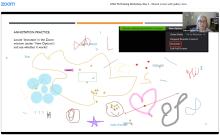The following is based on an interview with TA Coordinator and Associate Teaching Professor Laura McGarrity.
How can we make online classes more interactive?
A simple strategy is to occasionally stop screen sharing your slides so everyone in the class can see each other. It’s easy to maintain an “instructional presence” with your students, whether online or in person, but it’s much harder to cultivate a “social presence” online. It’s important to consider both.
Many linguistics classes have traditionally been geared towards training students in data analysis, using worksheets in class. How can we see if students are actually working on them if their video isn’t turned on?
(a) Well, we can’t always, especially in breakout rooms. But borrowing a technique suggested by TA Naomi Shapiro, you can make some breakout rooms voluntary, which means interested students can then opt into them to work with other like-minded students. (b) Using shared Google docs for students to type their answers into allows you to see work being done in real time.
What types of assessment works best for an online class?
Online classes sometimes force us to think of new forms of assessment. Try: (a) credit/no-credit participation ‘quizzes’ after lecture videos to encourage students to self-check retention; (b) discussion threads where students respond to a posted prompt or to other students’ responses.
What are your thoughts on synchronous vs. asynchronous teaching?
The two are often pitted against each other, as if we should choose one or the other. There are pros and cons to each and it’s possible to incorporate the best of both. Try coupling pre-recorded lecture videos which students can watch on their own time with a weekly synchronous component to allow students to ask questions in real time.
What has been your approach to training TAs to cope with this year’s teaching environment?
In this fall’s (online) TA Training Workshop, Lead TA Jiahui Huang and I called upon our returning TAs (many who taught online in Spring) to share their experiences with the new TAs. Much of the above came from those discussions. We also try to maintain our ‘social presence’ with the TAs by sending out regular newsletters containing teaching tips that we find useful.
What aspects of teaching might be permanently changed as a result of this forced online experience?
It will certainly make us rethink some basic assumptions about teaching. Many of us would say we prefer in-person classes, but there are useful things to come out of online teaching as well. Online office hours are much easier than in-person office visits for working students and those who commute. Content videos recorded in a non-course-specific format may be reused in other courses, freeing up prep time. There’s no doubt students can struggle with online classes, but there’s some good to come out of it as well. It’s up to us to find it.
